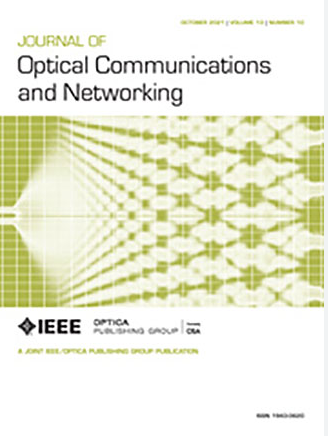Optimizing telemetry forwarding for distributed failure recovery in packet-optical networks
IF 4.3
2区 计算机科学
Q1 COMPUTER SCIENCE, HARDWARE & ARCHITECTURE
引用次数: 0
Abstract
Fast network recoverability from hard and soft failures is crucial for network operators to deliver uninterrupted services. Streaming telemetry has been studied as a solution for enabling fast and accurate failure detection in optical networks. However, significant delay is incurred when relying on a centralized entity (e.g., software-defined network controller) to collect, process, and act on telemetry data. Programmable switches (e.g., P4-based) allow telemetry data to be processed at line speed, enabling local on-device (distributed) decisions. These devices can be used to deploy quick and local mitigation to failures while a global solution is being computed on a longer time scale. However, designing network-wide streaming telemetry with distributed decisions remains an open challenge. In this work, we specify the joint optimization of packet-optical networks with on-device failure recovery, considering multiple aspects of the problem. The problem is modeled using linear programming and solved for multiple network realizations. The solutions can be used to program each switch in the network to detect failures and quickly recover the traffic. Results show that the proposed model decreases the required number of register entries to store telemetry data while assuring high recoverability and a minimized number of wavelengths.分组光网络中分布式故障恢复的遥测转发优化
从硬故障和软故障中快速恢复网络是网络运营商提供不间断服务的关键。流遥测技术是实现光纤网络快速、准确故障检测的一种解决方案。然而,当依赖于集中式实体(例如,软件定义的网络控制器)来收集、处理和处理遥测数据时,会产生明显的延迟。可编程开关(例如,基于p4的)允许以线路速度处理遥测数据,从而实现本地设备上(分布式)决策。这些设备可用于部署针对故障的快速和本地缓解措施,同时在更长的时间尺度上计算全球解决方案。然而,设计具有分布式决策的网络范围流遥测仍然是一个开放的挑战。在这项工作中,我们指定了具有设备上故障恢复的分组光网络的联合优化,考虑了问题的多个方面。该问题采用线性规划建模,并针对多个网络实现进行求解。该解决方案可用于对网络中的每个交换机进行编程,以检测故障并快速恢复流量。结果表明,该模型减少了存储遥测数据所需的寄存器条目数,同时保证了高可恢复性和最小波长数。
本文章由计算机程序翻译,如有差异,请以英文原文为准。
求助全文
约1分钟内获得全文
求助全文
来源期刊
CiteScore
9.40
自引率
16.00%
发文量
104
审稿时长
4 months
期刊介绍:
The scope of the Journal includes advances in the state-of-the-art of optical networking science, technology, and engineering. Both theoretical contributions (including new techniques, concepts, analyses, and economic studies) and practical contributions (including optical networking experiments, prototypes, and new applications) are encouraged. Subareas of interest include the architecture and design of optical networks, optical network survivability and security, software-defined optical networking, elastic optical networks, data and control plane advances, network management related innovation, and optical access networks. Enabling technologies and their applications are suitable topics only if the results are shown to directly impact optical networking beyond simple point-to-point networks.

 求助内容:
求助内容: 应助结果提醒方式:
应助结果提醒方式:


